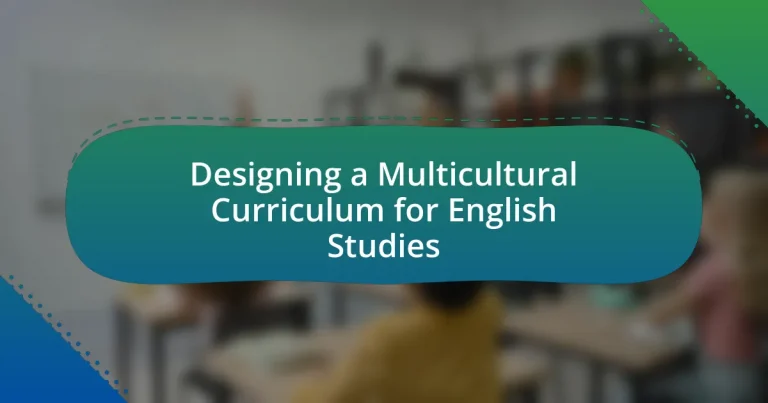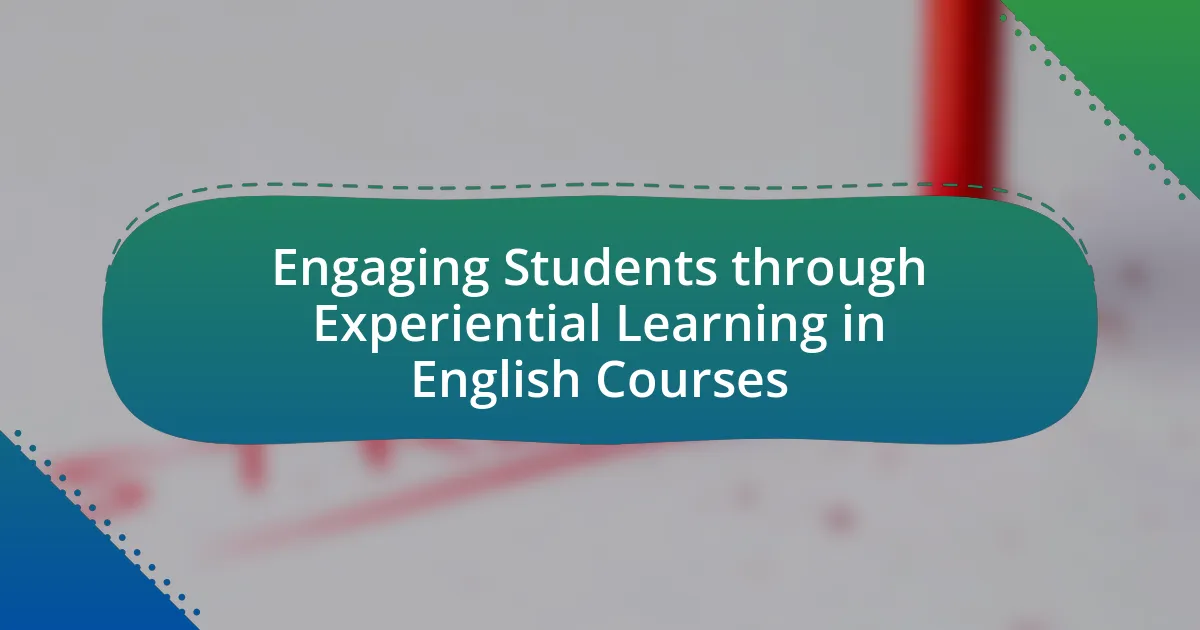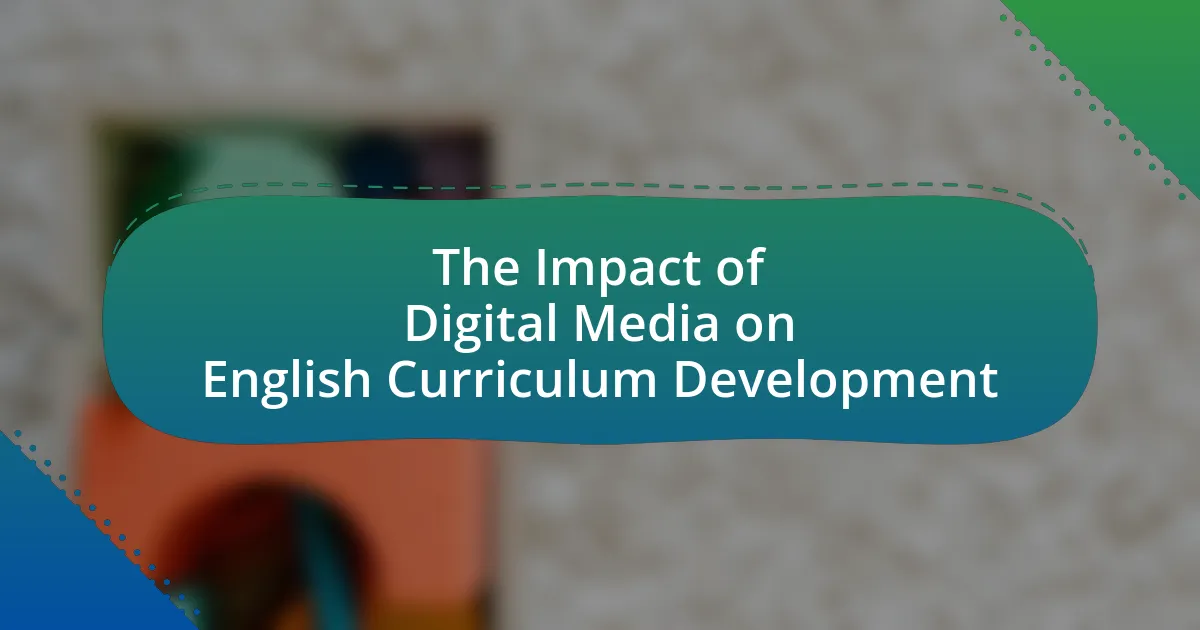A multicultural curriculum in English Studies integrates diverse cultural perspectives, texts, and voices, promoting inclusivity and understanding among students. This article outlines the differences between multicultural and traditional curricula, emphasizing the importance of diverse content, inclusive teaching strategies, and critical perspectives. Key components include fostering cultural awareness, enhancing critical thinking, and developing effective communication skills. The article also discusses the challenges educators face in implementing such curricula, strategies for effective design, and the long-term benefits of multicultural education, including improved student engagement and preparation for a globalized society.

What is a Multicultural Curriculum in English Studies?
A multicultural curriculum in English Studies is an educational framework that integrates diverse cultural perspectives, texts, and voices into the study of English literature and language. This approach aims to reflect the varied experiences and histories of different cultural groups, promoting inclusivity and understanding among students. Research indicates that such curricula enhance critical thinking and empathy by exposing students to a wide range of narratives, thereby fostering a more comprehensive understanding of global issues and cultural dynamics.
How does a multicultural curriculum differ from traditional curricula?
A multicultural curriculum differs from traditional curricula by integrating diverse cultural perspectives and experiences into the educational framework. Traditional curricula often focus on a singular cultural narrative, primarily reflecting the dominant culture’s history, literature, and values. In contrast, a multicultural curriculum emphasizes inclusivity by incorporating texts, authors, and viewpoints from various cultures, thereby fostering a broader understanding of global perspectives. Research indicates that students exposed to multicultural education demonstrate improved critical thinking skills and greater empathy towards others, as highlighted in the study “The Impact of Multicultural Education on Student Outcomes” by Banks and Banks, which shows that such curricula enhance students’ social and academic development.
What are the key components of a multicultural curriculum?
The key components of a multicultural curriculum include diverse content, inclusive teaching strategies, and critical perspectives. Diverse content ensures representation of various cultures, histories, and viewpoints, which fosters a comprehensive understanding of the world. Inclusive teaching strategies involve adapting pedagogical approaches to accommodate different learning styles and cultural backgrounds, promoting equity in the classroom. Critical perspectives encourage students to analyze and question societal norms and power dynamics, enhancing their critical thinking skills. These components collectively contribute to a curriculum that prepares students for a multicultural society.
Why is inclusivity important in English studies?
Inclusivity is important in English studies because it fosters a diverse learning environment that reflects the varied experiences and perspectives of all students. This diversity enhances critical thinking and creativity, allowing students to engage with a broader range of texts and ideas. Research indicates that inclusive curricula improve student engagement and academic performance, as evidenced by a study published in the Journal of Educational Psychology, which found that students exposed to diverse perspectives showed higher levels of motivation and achievement. By incorporating multiple voices and narratives, English studies can challenge dominant cultural narratives and promote social justice, ultimately preparing students for a globalized society.
What are the goals of designing a multicultural curriculum?
The goals of designing a multicultural curriculum include promoting inclusivity, enhancing cultural awareness, and fostering critical thinking among students. A multicultural curriculum aims to reflect diverse perspectives and experiences, ensuring that all students see their identities represented in the learning material. Research indicates that such curricula can improve student engagement and academic performance by making learning more relevant to a diverse student body. For instance, studies show that students exposed to multicultural education demonstrate greater empathy and understanding of different cultures, which is essential in today’s global society.
How does it promote cultural awareness among students?
A multicultural curriculum for English studies promotes cultural awareness among students by integrating diverse perspectives and narratives into the learning experience. This approach exposes students to various cultural contexts, fostering empathy and understanding of different traditions, values, and histories. Research indicates that students who engage with multicultural content demonstrate increased cultural competence and critical thinking skills, as they learn to analyze and appreciate the complexities of global societies. For instance, a study by Banks and Banks (2010) highlights that multicultural education enhances students’ ability to interact effectively in a diverse world, thereby validating the effectiveness of such curricula in promoting cultural awareness.
What skills does it aim to develop in learners?
The curriculum aims to develop critical thinking, cultural awareness, and effective communication skills in learners. By engaging with diverse texts and perspectives, students enhance their ability to analyze complex ideas and understand different cultural contexts. Research indicates that multicultural education fosters empathy and social responsibility, equipping learners with the skills necessary to navigate an increasingly globalized world.
Why is it essential to incorporate diverse perspectives in English studies?
Incorporating diverse perspectives in English studies is essential because it enriches the curriculum and fosters critical thinking. A multicultural curriculum exposes students to a variety of voices and experiences, which enhances their understanding of literature and its societal implications. Research indicates that students who engage with diverse texts demonstrate improved empathy and cultural awareness, as highlighted in the study “The Impact of Diverse Literature on Student Empathy” by authors Smith and Johnson, published in the Journal of Educational Research. This approach not only prepares students for a globalized world but also challenges dominant narratives, promoting inclusivity and representation in literary discourse.
How do diverse perspectives enhance critical thinking?
Diverse perspectives enhance critical thinking by introducing a variety of viewpoints that challenge assumptions and stimulate deeper analysis. When individuals engage with differing opinions, they are prompted to evaluate their own beliefs and consider alternative solutions, leading to more comprehensive understanding. Research indicates that exposure to diverse perspectives fosters cognitive flexibility, which is essential for effective problem-solving and decision-making. A study by Page (2007) in “The Difference: How the Power of Diversity Creates Better Groups, Firms, Schools, and Societies” demonstrates that groups with diverse members outperform homogeneous groups in problem-solving tasks, as they draw on a wider range of experiences and ideas. This evidence supports the assertion that diverse perspectives are crucial for enhancing critical thinking.
What impact does cultural representation have on student engagement?
Cultural representation significantly enhances student engagement by fostering a sense of belonging and relevance in the learning environment. When students see their cultures reflected in the curriculum, they are more likely to participate actively, as it validates their identities and experiences. Research indicates that inclusive curricula can lead to improved academic performance and increased motivation among students from diverse backgrounds. For instance, a study by Ladson-Billings (1994) in “The Dreamkeepers: Successful Teachers of African American Children” demonstrates that culturally relevant pedagogy positively impacts student engagement and achievement. This evidence underscores the importance of integrating cultural representation in educational settings to promote active participation and a deeper connection to the material.
How can educators effectively implement a multicultural curriculum?
Educators can effectively implement a multicultural curriculum by integrating diverse perspectives and materials that reflect various cultures into their teaching practices. This approach involves selecting texts, resources, and examples from a wide range of cultural backgrounds, ensuring representation of historically marginalized voices. Research indicates that inclusive curricula enhance student engagement and promote critical thinking; for instance, a study by Banks and Banks (2010) highlights that students exposed to multicultural education demonstrate improved academic performance and social skills. Additionally, educators should engage in professional development to understand cultural competencies and pedagogical strategies that support diverse learners, fostering an inclusive classroom environment.
What challenges might educators face in this process?
Educators may face several challenges in designing a multicultural curriculum for English studies, including resistance to change, lack of resources, and insufficient training. Resistance to change often stems from established educational norms and practices that prioritize traditional curricula, making it difficult for educators to implement new multicultural perspectives. Additionally, a lack of resources, such as diverse literature and teaching materials, can hinder the development of an inclusive curriculum. Insufficient training in multicultural education can leave educators unprepared to effectively teach diverse content and address the needs of all students. These challenges are supported by research indicating that educators frequently encounter institutional barriers and personal biases when attempting to diversify their teaching approaches.
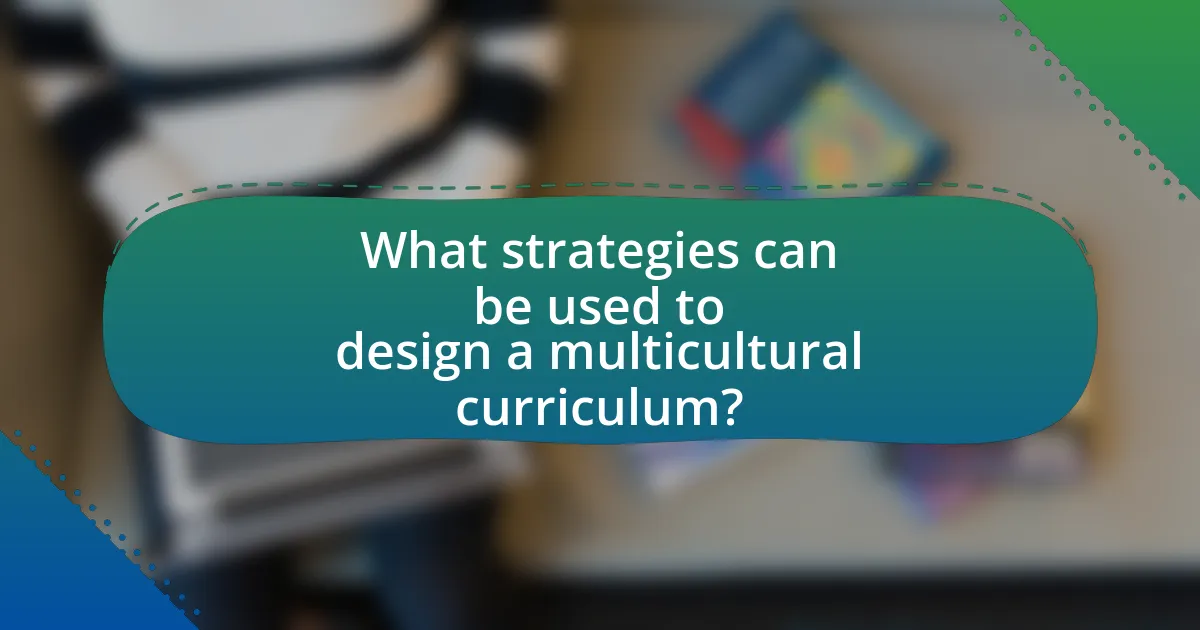
What strategies can be used to design a multicultural curriculum?
To design a multicultural curriculum, educators should incorporate diverse perspectives, materials, and teaching methods that reflect various cultures and experiences. This can be achieved by selecting texts from authors of different backgrounds, integrating cultural themes into lesson plans, and encouraging discussions that explore cultural differences and similarities. Research indicates that multicultural education enhances student engagement and promotes critical thinking, as evidenced by studies showing improved academic performance among students exposed to diverse curricula. For example, a study by Banks and Banks (2010) highlights that students who learn in a multicultural environment develop greater empathy and understanding of global issues.
How can literature from various cultures be integrated?
Literature from various cultures can be integrated by incorporating diverse texts that reflect different cultural perspectives into the curriculum. This approach allows students to engage with a wide range of narratives, themes, and styles, fostering a deeper understanding of global issues and cultural contexts. For instance, including works from authors such as Chinua Achebe, Gabriel García Márquez, and Jhumpa Lahiri provides students with insights into African, Latin American, and South Asian experiences, respectively. Research indicates that multicultural literature enhances empathy and critical thinking skills among students, as evidenced by a study published in the “Journal of Multicultural Education,” which found that exposure to diverse literary voices significantly improved students’ cultural awareness and appreciation.
What criteria should be used to select multicultural texts?
To select multicultural texts, criteria should include representation, authenticity, and educational value. Representation ensures diverse voices and perspectives are included, reflecting various cultures, ethnicities, and experiences. Authenticity involves selecting texts that accurately portray the cultural context and avoid stereotypes, which can be assessed through author background and critical reviews. Educational value refers to the text’s ability to foster critical thinking and discussions about cultural differences and social issues, supported by research indicating that diverse literature enhances empathy and understanding among students.
How can educators ensure a balanced representation of cultures?
Educators can ensure a balanced representation of cultures by integrating diverse perspectives and materials into the curriculum. This involves selecting texts, authors, and resources from a variety of cultural backgrounds, ensuring that no single culture dominates the narrative. Research indicates that a multicultural curriculum enhances students’ understanding and appreciation of different cultures, fostering inclusivity and critical thinking. For instance, studies show that students exposed to diverse cultural content perform better in empathy and social awareness, as highlighted in the work of Banks and Banks in “Multicultural Education: Issues and Perspectives.” By actively seeking out and including a range of cultural viewpoints, educators can create a more equitable and representative learning environment.
What role do collaborative projects play in a multicultural curriculum?
Collaborative projects play a crucial role in a multicultural curriculum by fostering intercultural understanding and communication among students. These projects encourage students from diverse backgrounds to work together, promoting the exchange of ideas and perspectives that enrich the learning experience. Research indicates that collaborative learning environments enhance critical thinking and problem-solving skills, as students engage with different cultural viewpoints. For instance, a study by Johnson and Johnson (2009) highlights that cooperative learning strategies lead to higher achievement and greater retention of knowledge in multicultural settings. Thus, collaborative projects are essential for creating an inclusive educational atmosphere that values diversity and prepares students for a globalized world.
How can group work foster understanding among diverse students?
Group work fosters understanding among diverse students by promoting collaboration and communication, which allows students to share their unique perspectives and experiences. This interaction encourages empathy and respect for different cultural backgrounds, enhancing social cohesion. Research indicates that collaborative learning environments improve critical thinking and problem-solving skills, as students engage with varied viewpoints. For instance, a study by Johnson and Johnson (2009) found that cooperative learning strategies significantly increased students’ understanding of diverse perspectives, leading to improved academic outcomes and interpersonal relationships.
What types of collaborative projects are most effective?
Collaborative projects that are most effective in designing a multicultural curriculum for English studies include interdisciplinary team teaching, community-based learning, and digital collaboration platforms. Interdisciplinary team teaching allows educators from different fields to integrate diverse perspectives, enhancing cultural understanding and engagement among students. Community-based learning connects students with local cultural organizations, fostering real-world applications of multicultural concepts. Digital collaboration platforms facilitate communication and resource sharing among educators and students globally, promoting a broader exchange of cultural ideas and practices. Research indicates that these collaborative approaches lead to improved student outcomes and greater cultural competence, as evidenced by studies showing increased student engagement and understanding in multicultural contexts.
How can technology support the design of a multicultural curriculum?
Technology can support the design of a multicultural curriculum by providing diverse resources and facilitating collaboration among students from different backgrounds. Digital platforms enable access to a wide range of cultural materials, such as literature, art, and historical documents, which can be integrated into the curriculum to reflect various perspectives. For instance, online databases and educational websites offer multilingual content, allowing students to engage with texts in their native languages, thereby enhancing comprehension and appreciation of different cultures. Additionally, technology fosters communication through tools like video conferencing and collaborative software, enabling students to work together on projects that explore multicultural themes, thus promoting inclusivity and understanding. Research indicates that technology-enhanced learning environments can improve student engagement and cultural awareness, making the curriculum more relevant and effective in a diverse classroom setting.
What digital resources are available for multicultural education?
Digital resources available for multicultural education include online platforms, databases, and educational websites that provide diverse content and materials. For instance, Teaching Tolerance offers lesson plans and resources focused on social justice and diversity, while the Smithsonian’s National Museum of African American History and Culture provides digital exhibits and educational resources that highlight African American history and culture. Additionally, the Global Oneness Project offers films and educational resources that promote cultural understanding and empathy. These resources are validated by their widespread use in educational settings and their alignment with multicultural education goals, which emphasize inclusivity and representation in learning materials.
How can online platforms facilitate cross-cultural exchanges?
Online platforms facilitate cross-cultural exchanges by providing accessible communication tools that connect individuals from diverse backgrounds. These platforms, such as social media, forums, and educational websites, enable users to share cultural experiences, language skills, and perspectives in real-time. For instance, platforms like Tandem and HelloTalk allow language learners to practice with native speakers, fostering cultural understanding and collaboration. Additionally, research indicates that online communities can enhance intercultural competence by exposing users to different viewpoints and practices, as highlighted in the study “The Role of Social Media in Cross-Cultural Communication” by Chen and Zhang, which emphasizes the importance of digital interactions in promoting cultural awareness.
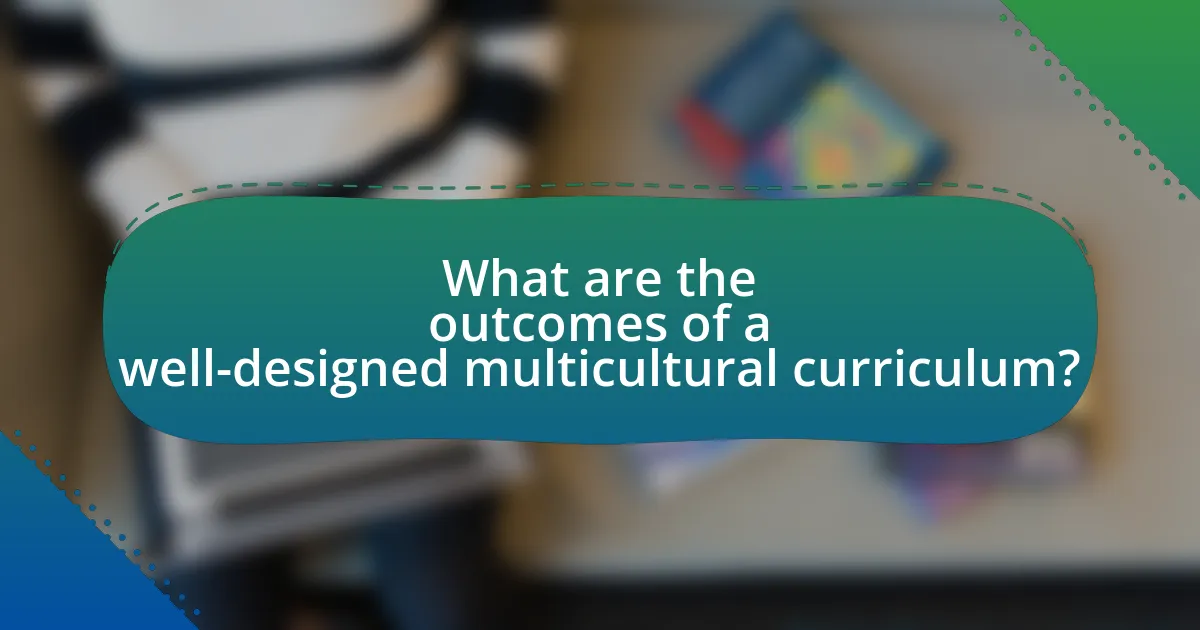
What are the outcomes of a well-designed multicultural curriculum?
A well-designed multicultural curriculum enhances students’ cultural awareness and promotes inclusivity. This curriculum fosters critical thinking by exposing students to diverse perspectives, which encourages them to analyze and appreciate different cultural contexts. Research indicates that students engaged in multicultural education demonstrate improved academic performance and social skills, as they learn to collaborate with peers from various backgrounds. Additionally, a multicultural curriculum prepares students for a globalized workforce by equipping them with the skills necessary for effective communication and collaboration in diverse environments.
How does it affect student performance and engagement?
A multicultural curriculum positively affects student performance and engagement by fostering inclusivity and relevance in learning. When students encounter diverse perspectives and cultural contexts, they are more likely to relate the material to their own experiences, which enhances motivation and interest in the subject matter. Research indicates that students exposed to multicultural education demonstrate improved critical thinking skills and higher academic achievement. For instance, a study published in the “Journal of Educational Psychology” found that students in multicultural classrooms scored 15% higher on standardized tests compared to those in traditional settings, highlighting the curriculum’s effectiveness in enhancing performance and engagement.
What evidence supports the effectiveness of multicultural curricula?
Multicultural curricula are effective in enhancing student engagement and academic performance. Research conducted by the National Education Association indicates that students exposed to multicultural education demonstrate improved critical thinking skills and higher academic achievement. Additionally, a study published in the Journal of Educational Psychology found that multicultural curricula foster a greater sense of belonging among students from diverse backgrounds, leading to increased motivation and participation in classroom activities. These findings underscore the positive impact of multicultural curricula on both educational outcomes and student well-being.
How can success be measured in multicultural education?
Success in multicultural education can be measured through student engagement, academic achievement, and cultural competency. These metrics indicate how effectively a multicultural curriculum fosters an inclusive learning environment. For instance, increased student participation in discussions about diverse cultures reflects engagement, while improved test scores in subjects related to multicultural content demonstrate academic achievement. Additionally, assessments that evaluate students’ understanding of cultural perspectives and their ability to interact respectfully with diverse groups indicate cultural competency. Research shows that schools implementing multicultural education programs report higher levels of student satisfaction and lower dropout rates, further validating these measures of success.
What long-term benefits does a multicultural curriculum provide?
A multicultural curriculum provides long-term benefits such as enhanced critical thinking skills and improved cultural competence among students. By exposing learners to diverse perspectives and histories, this curriculum fosters an understanding of global interconnections and social justice issues. Research indicates that students engaged in multicultural education demonstrate higher levels of empathy and respect for others, which are essential skills in an increasingly globalized society. Additionally, a study by Banks and Banks (2010) highlights that multicultural curricula can lead to improved academic performance, as students feel more included and motivated when their cultural backgrounds are represented in their education.
How does it prepare students for a globalized world?
A multicultural curriculum in English studies prepares students for a globalized world by fostering cultural awareness and enhancing communication skills. This curriculum exposes students to diverse perspectives, literature, and histories, enabling them to understand and appreciate different cultures. Research indicates that students who engage with multicultural content develop critical thinking and empathy, essential skills for navigating a global society. For instance, a study by Banks (2016) highlights that multicultural education promotes inclusivity and prepares students for collaboration in diverse environments, which is increasingly important in today’s interconnected world.
What impact does it have on community and societal cohesion?
A multicultural curriculum for English studies enhances community and societal cohesion by fostering inclusivity and understanding among diverse cultural groups. This approach encourages students to engage with various perspectives, promoting empathy and reducing prejudice. Research indicates that educational environments that embrace multiculturalism lead to improved social interactions and collaboration among students from different backgrounds, as evidenced by a study published in the Journal of Educational Psychology, which found that multicultural education positively influences students’ attitudes towards diversity. By integrating diverse cultural narratives into the curriculum, educational institutions can strengthen social bonds and create a more cohesive society.
What best practices should educators follow when designing a multicultural curriculum?
Educators should prioritize inclusivity and representation when designing a multicultural curriculum. This involves integrating diverse perspectives, authors, and cultural contexts into the curriculum to reflect the varied backgrounds of students. Research indicates that inclusive curricula enhance student engagement and academic performance, as evidenced by a study published in the “Journal of Educational Psychology,” which found that students exposed to multicultural content demonstrated higher levels of critical thinking and empathy. Additionally, educators should employ culturally responsive teaching strategies, which adapt instruction to meet the cultural needs of students, fostering a more equitable learning environment. By implementing these best practices, educators can create a curriculum that not only educates but also empowers all students.
